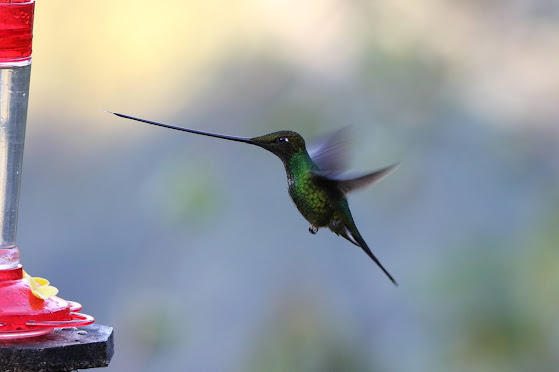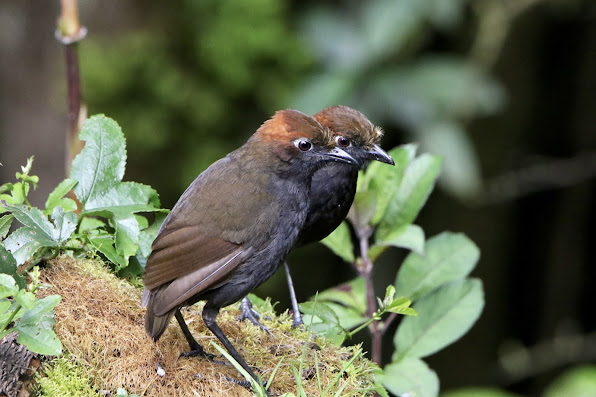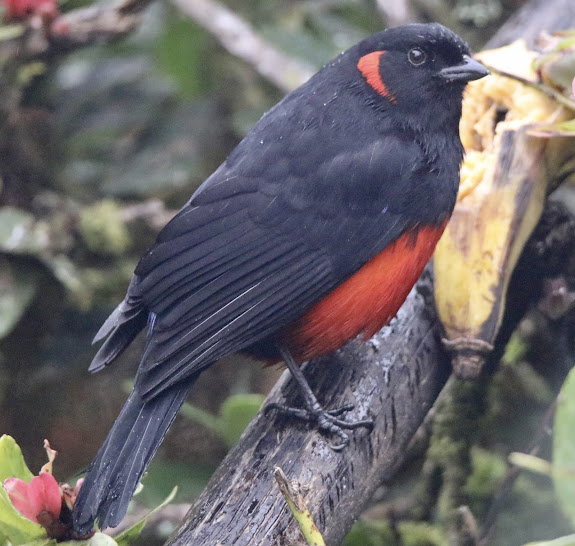3/24/21
Had to get up at 4:15 this morning as Javiar was taking me to a couple places west of Quito, one at just over 10,000 feet and the other at 11,500 feet. Cecil was driving and we certainly needed his high clearance truck and expertise driving to navigate and negotiate the roads. He also would be leaving me at my hostel afterward, so it was going to be a long day. We left at 4:30 and I felt a little part of me being left in Mindo. Friends made. Certain eateries patronized. Even saw a dentist for a chipped tooth. That was a real hoot since she did not speak English and we used google translate to communicate. But she got the job done in about 25 minutes and only charged me $30.00. When she was ready to use the hardening substance, she showed me that the tube was made in the USA. We had a good laugh about that. When she was finishing up she asked me if the tooth was too high. I told her it was like Mt Chimborazo (the highest mountain in Ecuador) and needed more taken off. She worked on it again and asked me again if it was still too high. I said it was like Mt Imbaurra (a much smaller mountain), so she took a little more off. I also took a tour of the El Quetzal Chocholate factory. Very educational. And of course lots of great birding there and nearby. I also met Rudy Gelis, one of Ecuador’s top birders and a very funny guy. I also took the long, steep trail at the Yellow-House Lodging and saw some Monkeys.
We left at 4:30 and got to our first destination by 06:30. The place was called “Zuro Loma,” or Bamboo Hill. The elevation here is 11,000 feet, and it gets a little chilly at times. It appeared to be a small piece of highland elfin forest set apart from all the small cattle farms taking up all the other available land. The manager met us, although I never learned his name. We first went downhill to a hummer feeding area where we saw 8 species of hummers, one of which was a lifer - the Sapphire-vented Puffleg. Here’s a few pics of them.
 |
| The enigmatic Sword-billed Hummingbird |
 |
| Sword-billed Hummingbird. I added this pic with the feeder for size comparison |
 |
| Buff-winged Starfrontlet |
 |
| Mountain Velvetbreast |
The manager spent about 10 minutes nearby calling for a pair of Chestnut-naped Antpittas, but was not successful. We then headed uphill to a ridge on which we walked the trail to another antpitta feeding spot. He put some worms on a horizontal log and played the song of the Rufous Antpitta a few times, but no response. So he left us there and went a short distance down the trail hoping to arouse an Ocellated Tapaculo, but he came back in 10 minutes saying he was a no show. 0 for 3 so far. It was not looking to be a very good start to the day. But he sat down, and in less than a minute he said they were coming, and sure enough in a few seconds a pair of Rufous Antpittas showed up. I’m not sure how he knew that because I did not hear anything nor see any movement. I had to be quick on the trigger getting pics because they only stayed for a few seconds to eat a worm or two, and then they disappeared back into the thicket.
 |
| Rufous Antpitta |
That was great! We then headed back to the first feeding spot, and when we were half way down the first trail again, he said the Antpittas were calling. I did not hear them, which is no big deal as I’m half deaf anyway. So I went into the he blind while he showed me where the birds would come, right up to the high point on the log where he put some worms. No sooner had he done that and one popped out of the brush and sped up the log to eat breakfast. He was soon followed by another. Both stayed for 10 minutes, which was about as long as the manager care to feed them.
 |
| Rufous-naped Antpitta |
 |
| Rufous-naped Antpittas |
Maybe the day was not starting out so badly after all. Besides the Antpittas, another lifer was a spiffy Gray-browed Brushfinch.
 |
| Gray-browed Brushfinch |
We actually stayed there for a solid 2 hours, and then it was off to the Yanacocha Reserve. Rosie and I had made a brief visit here 13 years prior, and I’ve wanted to go back ever since. Javiar had called to make a reservation 3 days prior, but when we got there the gate was locked and no one around. So he climbed over the fence and walked up to the reception area. In about 10 minutes one of the workers came down and unlocked the gate. Somehow our reservation did not reach the right people, but we were allowed to visit the place. After 7 weeks of birding almost every day I was never hampered by bad weather. So I guess it was about to happen.
We were now at 11,500 feet and the clouds had already engulfed the area. It really made birding difficult to say the least, but we were motivated just the same and made the best of it. The road into the reserve is about a mile and a half long which is the main place people bird, but there are a few side trails one can take also. That road turns into a trail half way along, and is on the side of a mountain, and the vegetation growth on both sides is really thick. This is a true cloud forest.
Birds were slow in coming. But the first lifer for me was finally found - a Rufous Spinetail. I even got decent looks at the skulker. Right after that a group of Rufous Wrens were all around us.
Then we heard a Undulated Antpitta below us. Javiar played their song on his iPhone. Next thing we knew there was one above us as well, and they kept coming closer. One was within 20 feet of us, but the growth was so thick it was hopeless seeing it. Shortly after that Javiar spied an Andean Guan, another lifer.
At the end of the trail were 2 professional photographers doing some documentary on hummingbirds, and they had quite the setup. Coming to one of their feeders were 2 more lifers - a Great Sapphirewing and a Golden-breasted Puffleg. Javiar knew there was a White-throated Screech Owl here, so played their song, and one flew in immediately. In a couple minutes we perceived there were 3 of them. One obliged us and perched about 30 feet away, and here is my best pic despite the foggy conditions.
 |
| White-throated Screech Owl |
The return walk was more productive for birds. We found a mixed flock which included Spectacled White-starts, a Blue-backed Conebill, a White-banded and a White-throated Tyranulet. I walked on ahead hoping to get a better look at the flock and found another Rufous Antpitta hopping down the trail in front of me.
Around one corner and perched on an outcropping was an Alpomado Falcon. He only stayed long enough to see him before he took off disappearing in the fog.
We made it back to the reception area and found our way to the small restaurant for lunch. That is when it hit me - altitude sickness. I felt lightheaded and could not concentrate very well. Javiar said I ought to drink some water, and the ladies came by with some kind of tea which was specifically for that sickness. I downed a cup of coffee as well. After the meal I felt better.
Then we went over to the hummer and banana feeding area. The Shining Sunbeams were in control of the feeders, chasing off any other hummers that came near.
 |
| I was hoping to get a similar photo of such away from a feeder, but no Shining Sunbeam ever allowed it. |
As there were no bananas for the tanagers Javiar went and got some, and soon there were both Masked and Glossy Flowerpiercers, Scarlet-bellied and Black-breasted Mountain Tanagers coming to eat.
 |
| Yellow-bellied Brushfinch |
 |
| Scarlet-bellied Mountain Tanager |
 |
| Black-chested Mountain Tanager |
After about 30 minutes it was starting to rain, so we decided to call it a day. On the way to Quito Javiar asked me if I wanted to see a White-bellied Woodstar, to which I said sure. So we side tracked a short distance which kind of looked familiar. I asked Javiar if this was the way to the San Jorge Lodge, and he said “yes, that is where we’re were going.” This was the place Rosie and I went when we first got to Quito in 2008. I’m pretty sure it is not open for business due to the pandemic, but the feeders were still maintained. We saw a female White-bellied Woodstar in about 1 minute, and I also added a Blue-headed Tanager and Cinereous Conebill to my trip list, which was now over 400. I have to say I hardly recognized the place, but do remember that first morning going out birding. I saw 44 species, 40 of which were lifers! Fun stuff.
It was then battling the traffic most of the way to the east side of the urban sprawl. It worked out very well to go to those places last as they were near Quito where I needed to be for the flight to Guayaquil the next day. Javiar is a young birder, in his 30s I think, and can keep up with the best of them I’d say. I met him near Ayampe some weeks before and was glad to hire a good guide, and also to give him business. All the birding guides in the country have been basically out of business for the last year, so I’m sure he could use the money by now.

No comments:
Post a Comment